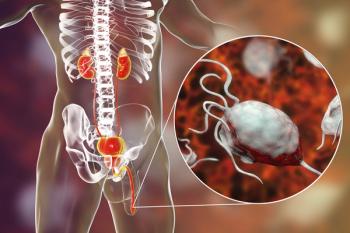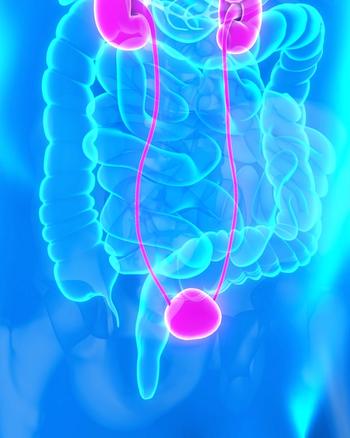
Oncology NEWS International
- Oncology NEWS International Vol 8 No 1
- Volume 8
- Issue 1
Androgen Ablation Added to RT in Locally Advanced Cancer
PHOENIX-Updated results from RTOG 86-10 show a continuing trend for improved overall survival among patients with locally advanced prostate cancer who received androgen ablation in addition to radiation therapy, compared with those receiving radiation therapy alone, Miljenko V. Pilepich, MD, reported at the annual meeting of the American Society for Therapeutic Radiology and Oncology (ASTRO).
PHOENIXUpdated results from RTOG 86-10 show a continuing trend for improved overall survival among patients with locally advanced prostate cancer who received androgen ablation in addition to radiation therapy, compared with those receiving radiation therapy alone, Miljenko V. Pilepich, MD, reported at the annual meeting of the American Society for Therapeutic Radiology and Oncology (ASTRO).
At 5 years, the survival curves overlap and then start to diverge. The P value at 8 years is .11, and the difference is about 10%, so it would appear that, with time, the figures will become significant statistically, said Dr. Pilepich, of St. Joseph Mercy Hospital, Ann Arbor, Michigan.
This phase III trial tested the hypothesis that androgen ablation before and during radiation therapy may enhance local control and eventually improve survival by diminishing the tumor bulk and by, in some favorable fashion, interacting on a cellular level with radiation, he said.
Eligible patients had bulky primary lesions (T2-T4) with or without pelvic lymph node involvement and without evidence of distant metastases. Patients were randomized to receive standard radiotherapy alone or with adjuvant androgen ablation consisting of goserelin (Zoladex), 3.6 mg monthly for 4 months, plus flutamide (Eulexin), 250 mg three times a day.
Of 471 patients enrolled, 456 were evaluable. Please note that close to 40% of the patients had elevated acid phosphatase, indicating the advanced nature of disease in this population, Dr. Pilepich pointed out. Median follow-up as of October 1998 was 6.5 years for all patients and 7.5 years for patients still alive.
The addition of androgen ablation significantly reduced the incidence of local failure, he said. At 5 years, 22% of the combination patients had a local recurrence vs 35% of those receiving radiotherapy alone. At 8 years, the corresponding numbers were 31% and 43%. Its worth noting that the curves remain separate, and there is no tendency to converge, he said.
The incidence of distant metastases was also significantly reduced in the combination arm, with a 10% difference at 8 years (35% vs 45%). The improvement in progression-free survival is also highly significant31% vs 21% at 8 years (P = .002).
So far, it would appear that androgen ablation has produced a very beneficial effect on all endpoints, Dr. Pilepich said. However, the question remains whether this treatment is applicable to all patients.
Subset Analysis
Subset analysis showed that patients with a Gleason score of 2 to 7 had a significantly reduced incidence of local failure (16%) with combination therapy, whereas patients with a Gleason score of 8 to 10 showed no benefit. The incidence of distant metastases was also not significantly different in the high Gleason score groups, he said, and disease-free survival, although quite strikingly improved in the low Gleason population with combination therapy, is barely different in the high Gleason population.
For overall survival, the difference in the low Gleason group has almost reached significance (P = .09), Dr. Pilepich said, but in the high Gleason population, the difference is not there at all.
He noted that in a parallel study in which androgen ablation was used long term, a remarkable improvement in outcome, including survival, was observed in the same population (Gleason 8 to 10).
Dr. Pilepich concludes that for patients with Gleason score of 2 to 7, four months of androgen ablation, as used in this trial, is adequate and beneficial, but that hormonal management should be applied for a much longer period in patients with high Gleason scores.
Articles in this issue
almost 27 years ago
Pittsburgh to Build New Cancer Centeralmost 27 years ago
NCI Initiates Two High-Priority Tobacco Research Programsalmost 27 years ago
Breast Cancer Stamp Sells Wellalmost 27 years ago
Hospital Strategies To Prevent Invasive Aspergillosis Spreadalmost 27 years ago
‘Cancer Patients Should Be Assertive, Know Their Rights’almost 27 years ago
EBCTCG Update of Adjuvant Treatment for Early Breast Canceralmost 27 years ago
Younger Breast Cancer Patients at Increased Risk of Recurrencealmost 27 years ago
Six Named to National Cancer Advisory Boardalmost 27 years ago
Trial Uses Vitamin A To Prevent Lung Cancer in Former Smokersalmost 27 years ago
‘Medical School Curriculum Must Include Palliative Care’Newsletter
Stay up to date on recent advances in the multidisciplinary approach to cancer.

















































































